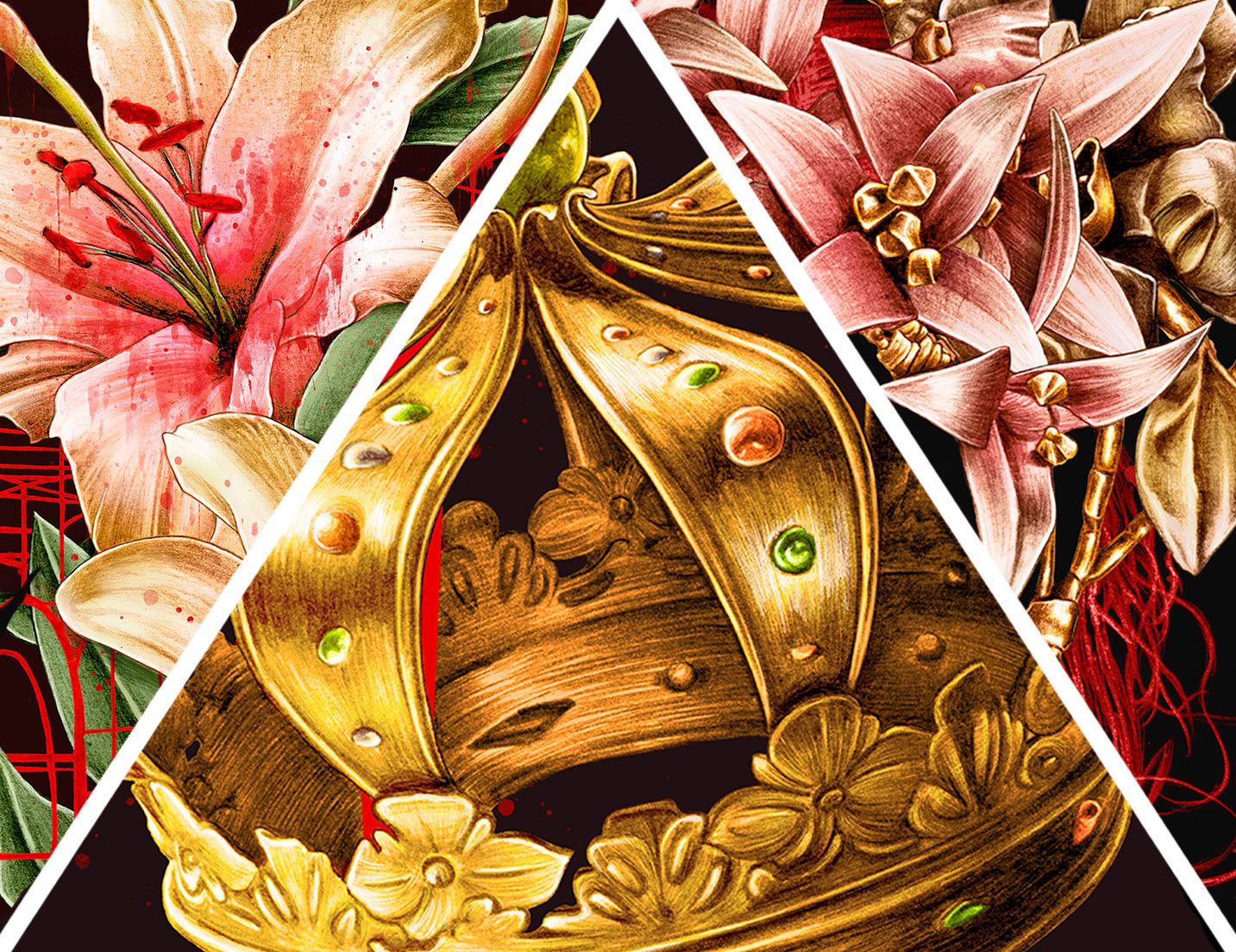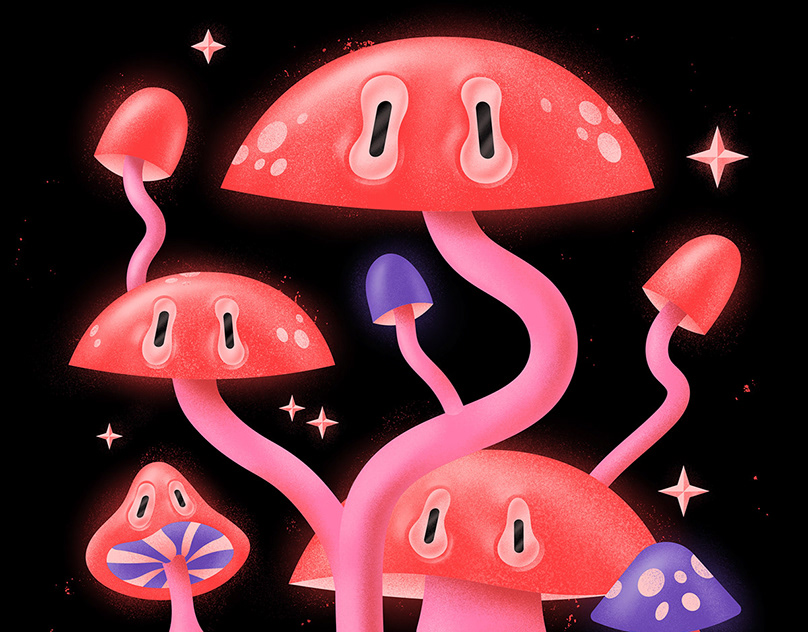
Project Overview
Institutions such as libraries, museums and archives, have long been recognised for their collection and preservation of artifacts as a means of conserving cultural memory. With an emergence of digital modes of archiving, emphasis has been placed on reproducing existing physical artifacts as digital representations, and archival of born-digital media.
By representing three-dimensional digitisations and born-digital media as two-dimensional counterparts, only a facet of the original artifact is depicted; discarding valuable visual and spatial information during translation. Information potentially essential to artifact contextualisation and understanding.

The software of this research, entitled Vertice, looks to provide a precedent for effectively representing three-dimensional digital artifacts within archive interfaces. Software for interfacing with archive collections was developed to explore how digital three-dimensional spatiality within cultural institution practice may enhance interaction between users and artifacts.
Using the gaming engine, Unity3D, the archive interface allows for importing three-dimensional digital artifacts, assigning metadata and artifactual information, as well as browsing and curation of artifact collections in their native three-dimensional spatiality. Specific emphasis was placed upon the narrative value of digital artifacts and their surrounding environment for facilitating unique forms of archival engagement.
preliminary research
Prior to undertaking thesis research, this project was preceded by the Victoria University of Wellington Summer Scholarship, Digital Archive of the Future. In collaboration with the National Library of New Zealand, this project looked to investigate the potential role of three-dimensional media in library and archive practice.
As a result, a number of speculative concepts were designed and proposed to the staff to act as catalysts for conversation around the topic. Notable amongst these is the My National Library, which outlined a visitor experience with similar sympathies to this project’s direction.

Initial thesis research area map
Photogrammetry Pipelines
The initial scope of this project sought to include an entire digitisation pipeline; encompassing the photogrammetry process through to the storage and engagement with the digitised artifacts. This scope proved to be much too ambitious later in the project, however, some early photogrammetry pipelines were developed using both proprietary and open software with Bash scripting for automation. These test scans were cleaned in software such as MeshLab and Cinema 4D before being used to trial high-polygon count models within the interface.

Proprietary digitisation pipeline using Agisoft PhotoScan

Semi-open digitisation pipeline using VisualSFM and MeshLab
user experience studies
To anticipate how users will adopt the Vertice software, a number of user experience exercises were undertaken.
User goals and concerns for using the software were derived from assumptive user personas. These were grouped into tasks and then abstracted further into events which provided the foundations for scenes within the software. Software events, tasks and goals were laid out in a user experience map, from which user experience models were extrapolated.

User personas derived from industry reports and literature


Hypothetical user models used to anticipate user adoption and identify two primary user types
metadata approach
Plans for including CRM and complex metadata relationships were modelled early in the project, inspired greatly by the approach to artifact metadata adopted at Museum of New Zealand Te Papa Tongarewa. The metadata system and object types eventually catered for by the interface became abstracted as the project progressed.

Initial inspiration for artifact and collection metadata structures

Artfact information metadata structure

Collection information metadata structure
interface functionality
Core functionality for the interface required extensive planning and modelling before implementation.
Aspects such as metadata communication, browsing systems, curation methods were mapped out prior to developing Unity tests. All functionality was implemented in Unity prior to GUI or environmental treatments.

Metadata and user interface model, exploring metadata attribution process

A key consideration became translating existing processes for 2D browsing into a 3D environment - depicted here is a grid system used by Vertice

Since the software was built within Unity, a number of game mechanics and interaction models were adopted - an example being the FPS input configuration
user interface development
After core functionality was largely completed, the software urgently needed to move beyond default GUI assets. The first step in this process was deciding what layout would cater for user experience and interaction needs most effectively. A number of wireframes were produced during this phases, connecting user experience with functionality developed for the software.
Having outlined rough wireframes, these layouts were refined further through project colour schemes and branding exercises. Beginning with 2D sketches in Illustrator, the final branding icons was produced in Cinema4D and applied throughout the software.
Having outlined rough wireframes, these layouts were refined further through project colour schemes and branding exercises. Beginning with 2D sketches in Illustrator, the final branding icons was produced in Cinema4D and applied throughout the software.

Early Browse scene wireframe
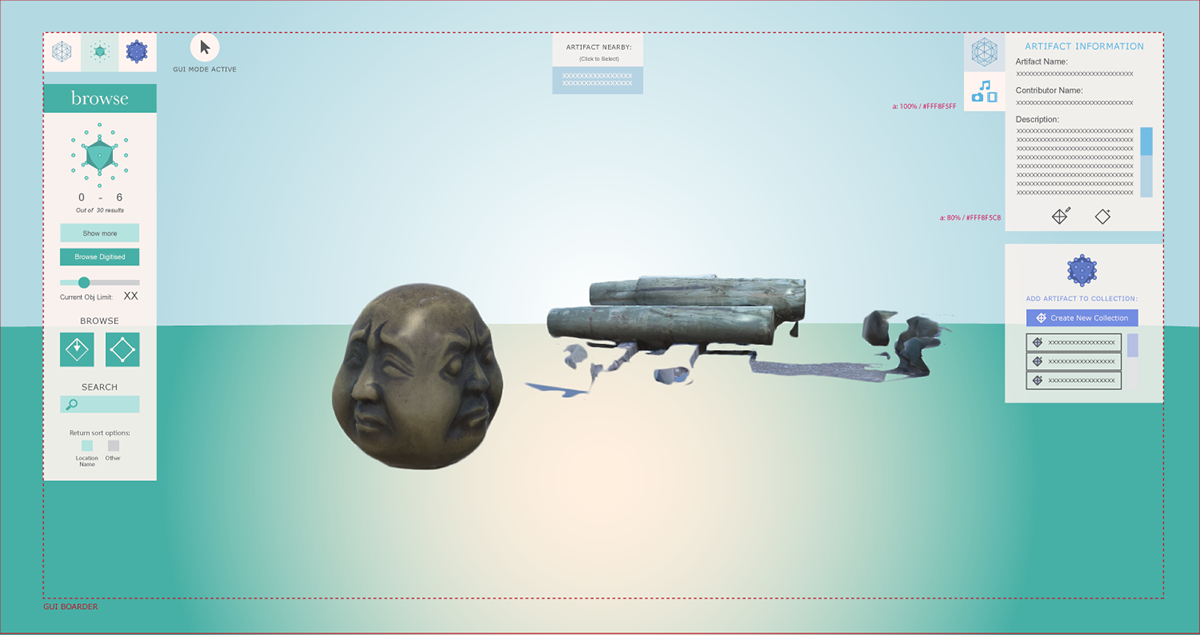
2D mock-up incorporating project branding

GUI design roughly implemented in Unity3D
environment treatment
The final phase in the software’s aesthetic development was designing the interface environment. Through the use of terrain and particle systems, the diegetic space could be exploited to a much greater potential.
Branding elements played an important role in informing design decisions as they were used to generate terrain heightmaps and act as portals between scenes.
Artifact scene treatment


Artefact scene zoom and rotation functionality used to inspect digital artefact quality and details
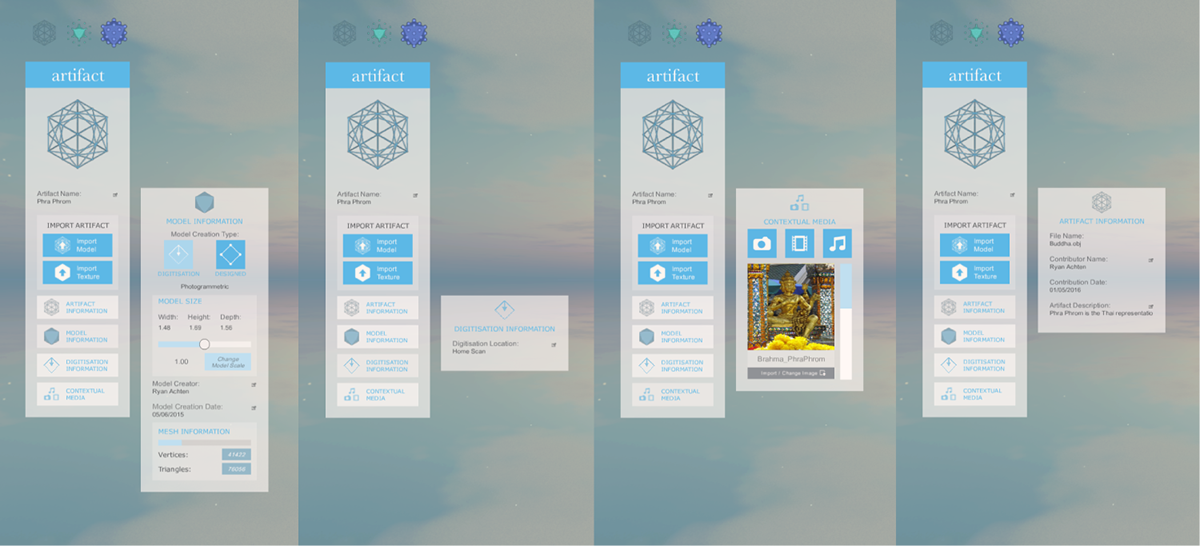
Information panels used to assign contextual information and media
Browse scene treatment


Particle locators used to help identify artefact locations
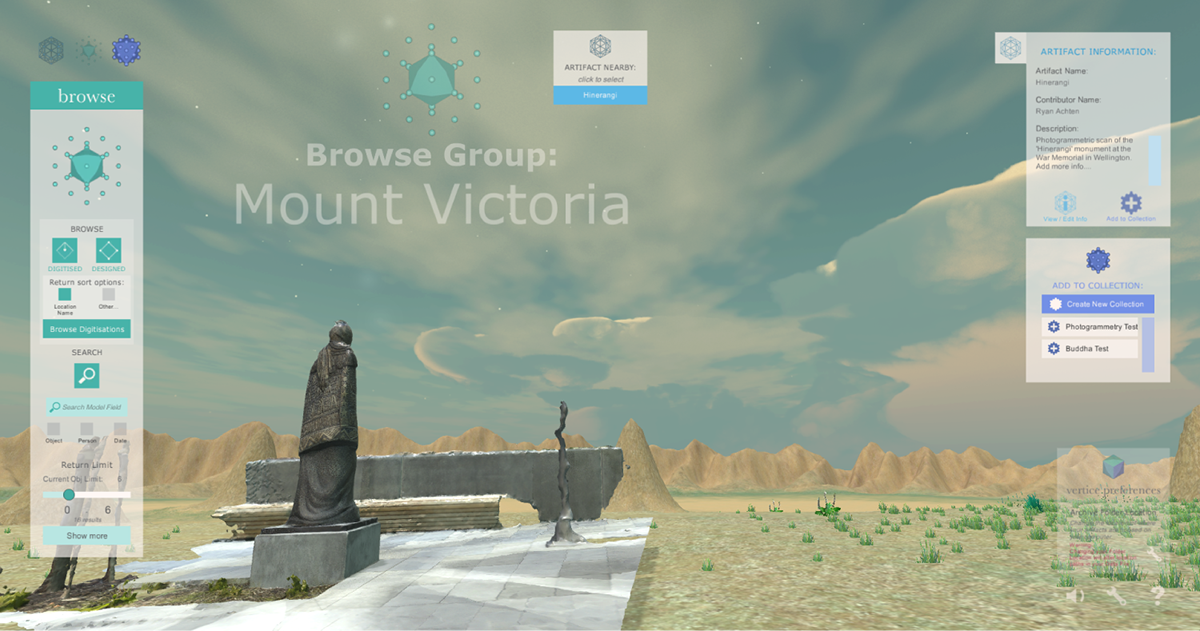
Artefact contextual information panel
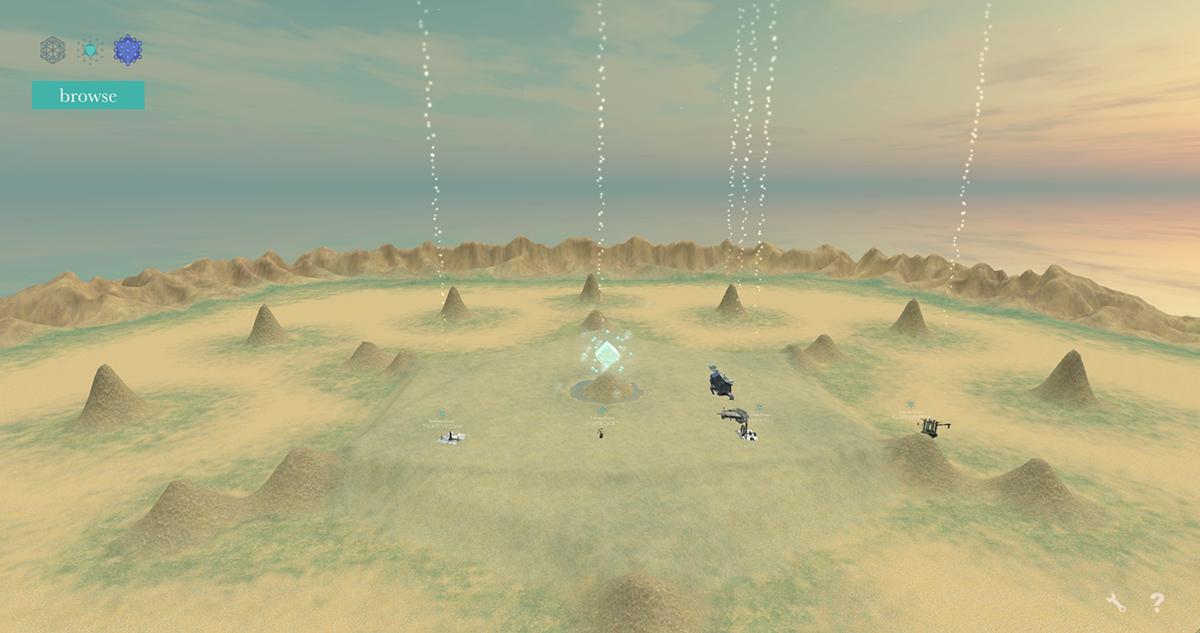
Artefacts laid out using the Browse scene's grid system
Collection scene treatment


Collection environment treatment

Modify panel for manipulating artefact positon, rotation, and scale

Vertice's MediaViewer used for viewing artefact contextual media (incl. images, audio and video)
project credits
Victoria University of Wellington, 2016
Submitted to the Victoria University of Wellington in fulfilment of the requirements for the degree of
Master of Design Innovation.
Submitted to the Victoria University of Wellington in fulfilment of the requirements for the degree of
Master of Design Innovation.
Research / Design / Development: Ryan Achten
Thesis Supervision: Walter Langelaar
Funded by VUW and Ministry of Business Innovation and Employment (MBIE) MDI Completion Grant.
Vertice has subsequently received funding from VUW's commercialisation office, VicLink and NZ innovation network, KiwiNet. The resulting project will be uploaded soon.
Thesis Supervision: Walter Langelaar
Funded by VUW and Ministry of Business Innovation and Employment (MBIE) MDI Completion Grant.
Vertice has subsequently received funding from VUW's commercialisation office, VicLink and NZ innovation network, KiwiNet. The resulting project will be uploaded soon.
All work produced by Ryan Achten, 2015-2016

